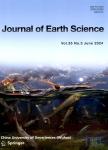Occurrence of Persea Mill. from the Siwalik Forest of Darjeeling, Eastern Himalaya: Paleoclimatic and Paleogeographic Implications
Occurrence of Persea Mill. from the Siwalik Forest of Darjeeling, Eastern Himalaya: Paleoclimatic and Paleogeographic Implications作者机构:Centre of Advanced StudyDepartment of BotanyUniversity of CalcuttaKolkata-700019India Department of BotanySidho-Kanho-Birsha UniversityPurulia 723104India
出 版 物:《Journal of Earth Science》 (地球科学学刊(英文版))
年 卷 期:2016年第27卷第5期
页 面:883-890页
核心收录:
学科分类:070903[理学-古生物学与地层学(含:古人类学)] 0709[理学-地质学] 07[理学] 0708[理学-地球物理学] 0704[理学-天文学]
基 金:financial assistance from the Department of Science and Technology New Delhi
主 题:Persea fossil leaves Middle Miocene Siwalik paleoelimate Darjeeling.
摘 要:Fossil leaf remains of two new species of Persea Mill., belonging to the family Lauraceae collected from the lower part of the Siwalik sediments(Gish Clay Formation of Sevok Group, Middle Miocene) of Darjeeling foothills of eastern Himalaya, are described. The new species are Persea miogamblei sp. nov. and Persea neovillosa sp. nov.. On the basis of leaf architecture(size, shape and venation pattern) fossil leaves described in this article closely resemble modern leaves of Persea gamblei(King ex Hook. f.) Kosterm. and Persea villosa(Roxb.) Kosterm.. The geographic distribution of the fossils and their modern counterparts are discussed and on that basis tropical evergreen vegetation with a warm and humid climate at the time of deposition of the Siwalik sediments is suggested in contrast to the present day tropical deciduous vegetation in this area. The present finding also suggests probable migration of these lauraceous taxa to Southeast Asia.



